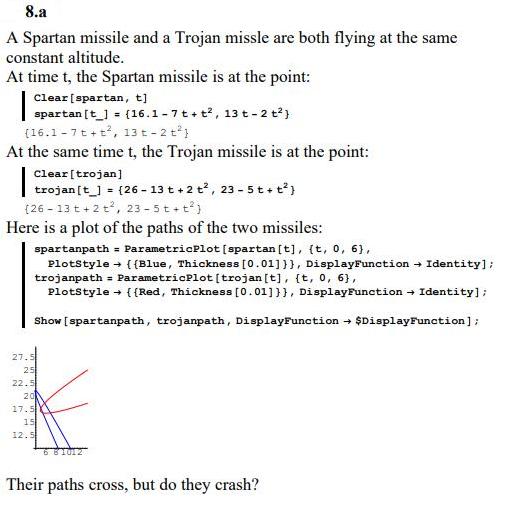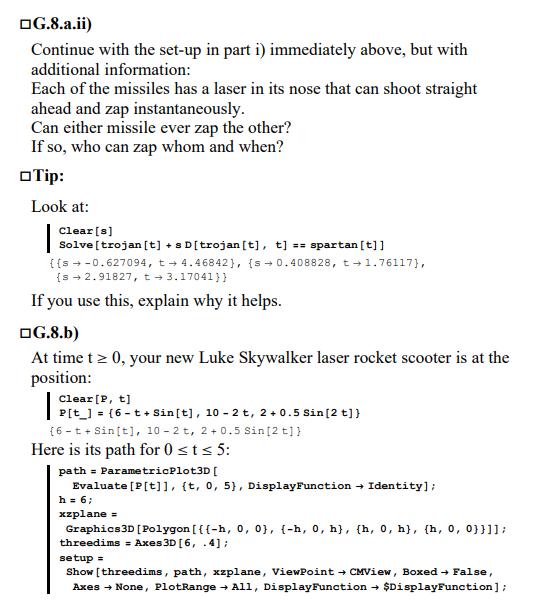8.a A Spartan missile and a Trojan missle are both flying at the s ame constant altitude. At time t, the Spartan missile is



8.a A Spartan missile and a Trojan missle are both flying at the s ame constant altitude. At time t, the Spartan missile is at the point: Clear[spartan, t] spartan[t_] = {16.1-7t+ t, 13 t - 2 t} (16.1 - 7t+t, 13 t - 2 t} At the same time t, the Trojan missile is at the point: Clear[trojan] trojan (t_] = (26 - 13 t + 2 t, 23 - 5 t+t) (26 - 13 t + 2 t, 23 - 5t +t) Here is a plot of the paths of the two missiles: spartanpath = ParametricPlot [spartan [t], (t, 0, 6), Plotstyle - {(Blue, Thickness [0.01]}}, DisplayFunction + Identity]; trojanpath = ParametricPlot [trojan [t], {t, 0, 6}, Plotstyle + ({Red, Thickness [0.01]}}, DisplayFunction + Identity]; Show [spartanpath, trojanpath, DisplayFunction + $DisplayFunction]; 27.5 25 22.5 20 17.5 12.9 Their paths cross, but do they crash? OG.8.a.ii) Continue with the set-up in part i) immediately above, but with additional information: Each of the missiles has a laser in its nose that can shoot straight ahead and zap instantaneously. Can either missile ever zap the other? If so, who can zap whom and when? O'Tip: Look at: Clear [s] Solve [trojan [t] + s D[trojan [t], t] == spartan [t]] {{s - -0.627094, t+ 4.46842}, {s -0.408828, t-1.76117}, {s - 2.91827, t 3.17041}} If you use this, explain why it helps. OG.8.b) At time t z 0, your new Luke Skywalker laser rocket scooter is at the position: Clear[P, t] P[t_] = (6 -t+ Sin[t], 10 - 2 t, 2+ 0.5 Sin[2 t]} (6 -t + Sint], 10 - 2 t, 2+0.5 sin[2 t]} Here is its path for 0 sts 5: path = ParametricPlot3D [ Evaluate [P[t]], (t, 0, 5}, DisplayFunction + Identity]; h= 6; xzplane = Graphics3D [ Polygon [{{-h, 0, 0}, (-h, 0, h}, {h, 0, h}, (h, 0, 0}}]]: threedims = Axes3D [6, .4]: setup = Show [threedims, path, xzplane, ViewPoint + CMView, Boxed + False, Axes + None, PlotRange + All, DisplayFunction + $DisplayFunction]; A laser beam emanates from the nose cone of your scooter and shoots out in in a straight line tangent to the path lkiie this: time = 3.3; samplebeam = Arrow [ P' [time], Tail + P[time], VectorColor - Red, ScaleFactor + 4.5]; Show [setup, samplebeam]; Note that the beam pierces the xz-plane. Imagine that the xz-plane is made of cardboard, and plot the curve burned into the xz-plane by your scooter's laser during the time interval 0 sts 5. oTip: Look at: | P[t] + s P' [t] {6 -t+s (-1+ Cos [t]) + Sin[t], 10 - 2 s - 2 t, 2+1. s Cos [2 t] + 0.5 Sin[2 t]} | (P(t] + s P' [t]) [2] 10 - 2 s - 2 L | Solve [ (P[t] + s P' [t]) [2] == 0, s] {{s - 5 - t}}
Step by Step Solution
3.37 Rating (156 Votes )
There are 3 Steps involved in it
Step: 1

See step-by-step solutions with expert insights and AI powered tools for academic success
Step: 2

Step: 3

Document Format ( 2 attachments)
635e34eb4acfb_182355.pdf
180 KBs PDF File
635e34eb4acfb_182355.docx
120 KBs Word File
Ace Your Homework with AI
Get the answers you need in no time with our AI-driven, step-by-step assistance
Get Started


